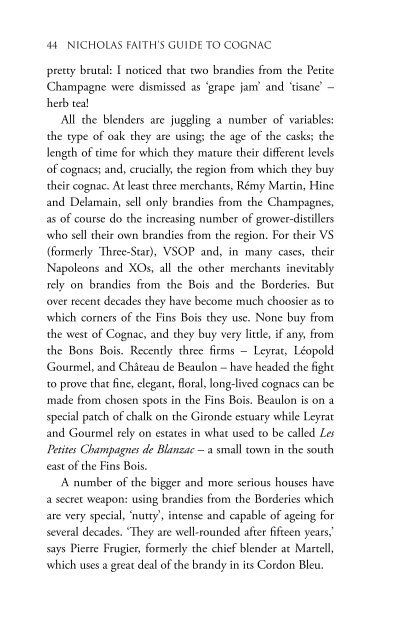You also want an ePaper? Increase the reach of your titles
YUMPU automatically turns print PDFs into web optimized ePapers that Google loves.
pretty brutal: I noticed that two brandies from the Petite<br />
Champagne were dismissed as ‘grape jam’ and ‘tisane’ –<br />
herb tea!<br />
All the blenders are juggling a number of variables:<br />
the type of oak they are using; the age of the casks; the<br />
length of time for which they mature their different levels<br />
of cognacs; and, crucially, the region from which they buy<br />
their cognac. At least three merchants, Rémy Martin, Hine<br />
and Delamain, sell only brandies from the Champagnes,<br />
as of course do the increasing number of grower-distillers<br />
who sell their own brandies from the region. For their VS<br />
(formerly Three-Star), VSOP and, in many cases, their<br />
Napoleons and XOs, all the other merchants inevitably<br />
rely on brandies from the Bois and the Borderies. But<br />
over recent decades they have become much choosier as to<br />
which corners of the Fins Bois they use. None buy from<br />
the west of <strong>Cognac</strong>, and they buy very little, if any, from<br />
the Bons Bois. Recently three firms – Leyrat, Léopold<br />
Gourmel, and Château de Beaulon – have headed the fight<br />
to prove that fine, elegant, floral, long-lived cognacs can be<br />
made from chosen spots in the Fins Bois. Beaulon is on a<br />
special patch of chalk on the Gironde estuary while Leyrat<br />
and Gourmel rely on estates in what used to be called Les<br />
Petites Champagnes de Blanzac – a small town in the south<br />
east of the Fins Bois.<br />
A number of the bigger and more serious houses have<br />
a secret weapon: using brandies from the Borderies which<br />
are very special, ‘nutty’, intense and capable of ageing for<br />
several decades. ‘They are well-rounded after fifteen years,’<br />
says Pierre Frugier, formerly the chief blender at Martell,<br />
which uses a great deal of the brandy in its Cordon Bleu.<br />
THE BIG FOUR<br />
A mere four people, including a woman for the first<br />
time in the near-four hundred year history of <strong>Cognac</strong>,<br />
are responsible for producing around 150 million bottles<br />
of cognac a year. They are the chef de caves or maîtres<br />
de chai for the four firms which account for the vast<br />
majority of cognacs sold in the world.<br />
Their job is even more complex than that facing their<br />
only real brethren, the people responsible for producing<br />
Scotch and other whiskies. Both groups have to produce<br />
millions of bottles in a range of ages and qualities in<br />
quantities which can fluctuate widely from year to year<br />
– and even more so from decade to decade. But the<br />
<strong>Cognac</strong>ais have a unique complication: they are not<br />
buying their raw material wholesale from a handful of<br />
grain merchants but in relatively small quantities from<br />
several thousand small farmers who may provide grapes,<br />
or wine, or cognac which is usually newly distilled but<br />
may have been aged. So they have to add diplomacy to<br />
their other essential qualities – such as expert taster and<br />
blender to name but two.<br />
It is the more extraordinary that only one of the four is<br />
a native of <strong>Cognac</strong>. Yann Fillioux, the veteran blender for<br />
Hennessy, far and away the biggest firm in <strong>Cognac</strong>, is in<br />
some ways a godfather figure to the whole community.<br />
Indeed, he is the seventh member of the family to have<br />
blended cognac for the Hennessy family and since he<br />
succeeded his uncle Maurice twenty years ago has had<br />
to double production and introduce a number of new<br />
cognacs while not diluting the style or quality of the


